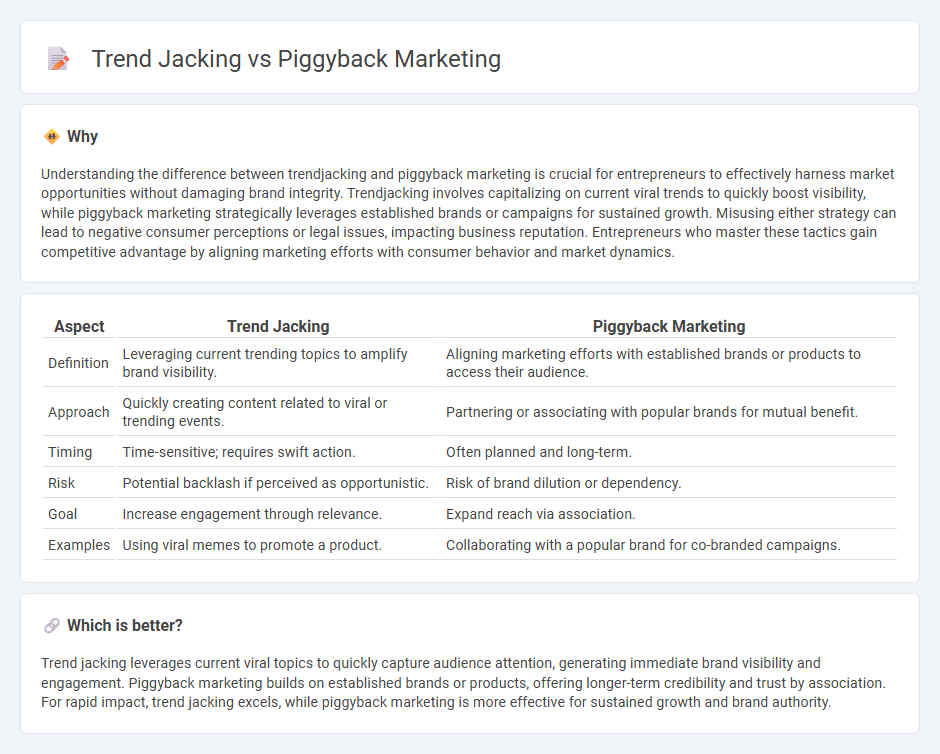
Trend jacking leverages current popular topics or viral events to swiftly boost brand visibility and engagement, while piggyback marketing aligns with established brands or products to access their audience and credibility. Both strategies require precise timing and relevance to maximize impact and avoid appearing opportunistic. Explore how mastering these approaches can elevate your entrepreneurial marketing efforts.
Why it is important
Understanding the difference between trendjacking and piggyback marketing is crucial for entrepreneurs to effectively harness market opportunities without damaging brand integrity. Trendjacking involves capitalizing on current viral trends to quickly boost visibility, while piggyback marketing strategically leverages established brands or campaigns for sustained growth. Misusing either strategy can lead to negative consumer perceptions or legal issues, impacting business reputation. Entrepreneurs who master these tactics gain competitive advantage by aligning marketing efforts with consumer behavior and market dynamics.
Comparison Table
| Aspect | Trend Jacking | Piggyback Marketing |
|---|---|---|
| Definition | Leveraging current trending topics to amplify brand visibility. | Aligning marketing efforts with established brands or products to access their audience. |
| Approach | Quickly creating content related to viral or trending events. | Partnering or associating with popular brands for mutual benefit. |
| Timing | Time-sensitive; requires swift action. | Often planned and long-term. |
| Risk | Potential backlash if perceived as opportunistic. | Risk of brand dilution or dependency. |
| Goal | Increase engagement through relevance. | Expand reach via association. |
| Examples | Using viral memes to promote a product. | Collaborating with a popular brand for co-branded campaigns. |
Which is better?
Trend jacking leverages current viral topics to quickly capture audience attention, generating immediate brand visibility and engagement. Piggyback marketing builds on established brands or products, offering longer-term credibility and trust by association. For rapid impact, trend jacking excels, while piggyback marketing is more effective for sustained growth and brand authority.
Connection
Trend jacking leverages current popular topics or trends to amplify a brand's visibility, while piggyback marketing strategically aligns a product with an established brand or event to boost credibility and reach. Both techniques capitalize on existing consumer attention and market momentum to accelerate entrepreneurial success. Entrepreneurs harness these interconnected strategies to enhance brand awareness, drive engagement, and maximize marketing efficiency in competitive markets.
Key Terms
Leverage
Piggyback marketing leverages the existing popularity of a well-established brand or event to promote a related product, ensuring alignment with the target audience's interests. Trend jacking capitalizes on viral trends or breaking news to gain quick visibility, often requiring rapid content creation to stay relevant. Explore strategic examples to understand how to effectively leverage both approaches for maximum marketing impact.
Timing
Piggyback marketing leverages established campaigns by aligning messaging closely with a popular brand or event, maximizing impact through coordinated timing. Trend jacking rapidly capitalizes on emerging trends or viral moments to gain immediate attention, often requiring swift execution to stay relevant. Explore deeper insights into optimal timing strategies for both approaches to enhance your marketing effectiveness.
Brand Alignment
Piggyback marketing leverages existing, compatible brand narratives to amplify message resonance, ensuring seamless brand alignment without compromising identity. Trend jacking capitalizes on viral trends but risks brand dilution if the trend contradicts core values. Explore in-depth strategies to maintain brand coherence while riding market waves.
Source and External Links
What is Piggyback Marketing? Definition, Examples, Rules - Piggyback marketing is a cost-effective strategy where two or more companies that offer complementary, non-competing products promote each other's products to reach new target audiences and increase sales.
Piggyback Marketing - Definition & Meaning - This strategy often helps smaller or local businesses enter new or foreign markets by partnering with established firms, leveraging complementary products for maximum promotion with low costs.
Piggyback marketing - CEOpedia | Management online - Piggyback marketing involves associating a brand with an established brand to gain exposure and credibility, often through partnerships, sponsorships, or co-branding with complementary products.
 dowidth.com
dowidth.com